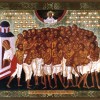Source: http://www.orthodox.clara.net/
 One big difference between the Eastern and Western Church traditions lies in their approach to weddings and marriages. In the West, the couple are said to marry one another “I Joe take you Pru to be my wedded wife” and then the priest blesses their action. This, it is claimed, absolves the church concerned from blame over any subsequent marital breakdown.
One big difference between the Eastern and Western Church traditions lies in their approach to weddings and marriages. In the West, the couple are said to marry one another “I Joe take you Pru to be my wedded wife” and then the priest blesses their action. This, it is claimed, absolves the church concerned from blame over any subsequent marital breakdown.
In the East, the service is regarded as a sacrament because the priest commands God to marry the bride and groom. In our Orthodox Marriage service the priest addresses God directly saying “Do Thou Thyself now…..stretch forth Thy hand from Thy Holy dwelling place, and join together this Thy servant, Joe, and this Thy hand-maiden, Pru, for by Thee is a man joined to a woman. Unite them in oneness of mind, crown them in one flesh, granting them fruit of the womb, and the gain of fair children. For Thine is the might etc.”
The gap between the two traditions at this point is, therefore, very big; but it is not the only difference in this area of marriages. The Orthodox Church regards marriage as one of the paths to true holiness of life, that is, it is seen as a way of salvation. Fine, many people would agree with that. But what is the other main line to holiness and salvation in the Christian East? And the answer to that question comes a shock to many because it is monasticism. The Church regards holiness/salvation is possible in the main/for the vast majority of people by either marriage or monasticism.
It is true that it is possible to find Eastern writers who give the impression that they regard monasticism as the higher ideal — but that is their personal opinion, and as one contemporary monastic explains, “Discussion comparing marriage and monasticism are rarely profitable. Each person must find his own path of salvation by asking God to show him which path is best for him — and then work out his salvation (Phil.2.12) in the circumstances God has given him. We compromise our salvation by not choosing one way of life or another, but by falling away from the will of God concerning ourselves personally. Ultimately, then, the decision to marry, become a monastic, or live as a celibate in the world, is a matter of personal gift and calling, and one must choose the way which will most assure one‟s own salvation” (Sr Magdalen, Tolleshunt Knights Monastery, in her book: “Children in the Church Today”)‟
Two important points are being made here as regards our discussion and the first is really a warning against drifting through life with the view to “seeing what happens.”
With the Church’s encouragement, we are urged first, to see our life as the route to salvation, and then sort our whether our route to that destination is going to be via marriage or monasticism. Now, undoubtedly, this is a very high ideal but I can’t help feeling that if only we could get this across to our young people today, it may save many an unhappy lifestyle from developing.
The second point which concerns us, is that the marriage service, as you would now expect, contains some cross references to the life of the monastic, that is, there are some reminders that marriage is not a bed of roses but a life of self-denial; of putting God first, the partner second and self last; again a high ideal but entirely within our grasp.
Immediately after the request, already quoted, to God to join together the couple in Holy Matrimony, the priest put crowns on their heads and these are joined by a length of ribbon. Then they take their first steps of married life as they walk, led by the priest, three times round the makeshift altar-table which has been set up in the middle of the Church. The walk is called the “Dance of Isaiah” from the first hymn sung during it, and it symbolises the couple’s commitment always to be led by Christ, and to have His teaching, proclaimed in the Gospels lying there on the table, at the centre of their lives.
And the crowns? They have two different themes intertwined. First is St Paul’s picture of the winner in the earthly Olympics who is crowned with a wreath which will soon fade and wither. But we run, St Paul says, “to obtain a crown which will last for ever” (I Cor9.24/25). Again, he says to Timothy:- “I have fought the good fight; I have finished my course; I have kept the faith: henceforth there is laid up for me a crown of righteousness” (2 Tim.4.7/8).
Certainly, the other way in which crowns appear in Christian usage are in icons on the heads of martyrs, that is, those who have born witness (= what the word “martyr” means) to Christ through giving up their lives rather than betray Him. “Be faithful unto death, and I will give thee the crown of life” says Jesus in Revelation (2.10).
None of this, of course, is meant to imply morbid interest in the suffering side of marriage — that is a modern gloss put on the symbolism — because in the service, the bride and bridegroom are promised happiness and prosperity, not suffering. This is well brought out in the readings from scripture. The Apostle reading is from Ephesians 5:20-33 where St Paul puts the mystery of marriage on a par with the mystery of the Church. He aims to show the unity of Christ with His Church and he can think of no better simile than that of the marriage union. But it is not marriage which serves as a model for understanding Christ / Church relationships, but rather it is the other way round — this relationship is said to be part of Christian experience which marriage is called to reflect … very subtle and very interesting.
The Gospel reading is the story of the Wedding Feast at Cana from St John chapter 2.
Like most of St John’s passages this has a double meaning. On the surface it tells a fact of Jesus‟ life but at a deeper level it points to man’s salvation through its spiritual/sacramental aspect. The change of water into wine points to a transfiguration of the old into the new, a passage from death to life, and so, like the rest of the marriage service “it announces the possibility of changing the old, natural order of things into a joyful celebration of God’s presence among men,” claims Fr John Meyendorff. Also, the saving of the best wine until the last is an appropriate theme for a good marriage — as the years pass, the couple become closer together and the wine of their love becomes better and better.
Throughout the wedding service then, the Church is presenting married life as the preparation for eternity. She is saying to the newly-weds:–“You have worn these crowns briefly in your earthly life together; now strive to win the heavenly crowns that you will wear for ever in Heaven.” A high ideal, certainly, but it does underscore the truth that our life here and in eternity is all one, and we need every reminder of this truth.

















